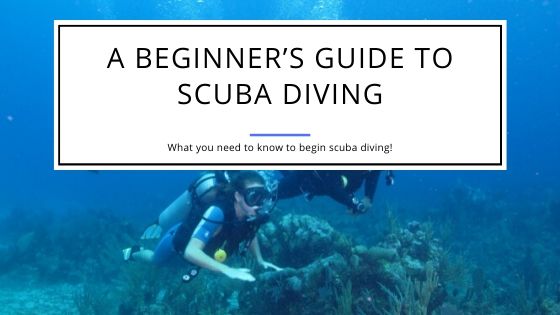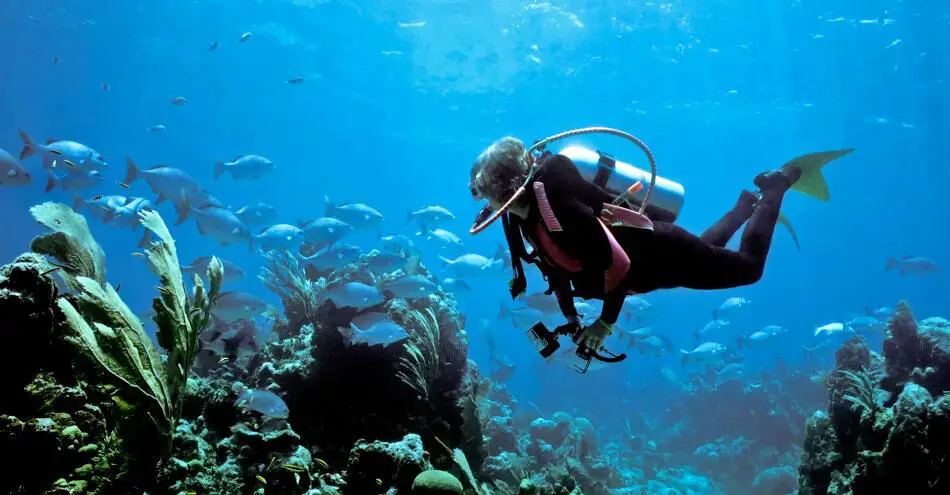A Beginner’s Guide to Scuba Diving
Scuba diving can be an exciting and fun experience, but it should not be taken lightly as an activity you can do without any prior knowledge or the help of an experienced scuba diver. There are many components that go into becoming a scuba diver or even just going scuba diving.
With this guide, you can be on your way to exploring the great underwater world without being worried. You will have all the knowledge you need to get started! However, keep in mind that the deep blue underwater world can be dangerous, and this guide cannot replace the first-hand experience of scuba lessons on how to scuba dive, which are absolutely imperative before you actually go in the water.
Need a new regulator? Check out our in-depth buying guide for scuba diving regulators!
Keeping that in mind, let’s dive in:
What is Scuba Diving?
Scuba diving is a great way to get up close and personal with the aquatic world; uncovering all its secrets and interacting with all the beautiful and colorful creatures that inhabit this mysterious place.
How do you choose a scuba dive computer? What do you need to know?
If you were ever wondering where the word SCUBA came from, it actually stands for Self-Contained Underwater Breathing Apparatus. Unlike in snorkeling, the breathing device does not rely on the surface for air supply. Divers carry tanks of compressed or enriched air on their backs (ever wondered how much compressed air weighs?), which allow them longer dives than those holding their breath, and deeper dives than those relying on the surface for oxygen. These gas tanks (one or more) are connected to an air hose and a device, which is known as the demand regulator. The demand regulator (like the Aqualung Legend) helps control the airflow to ensure the air pressure within the diver’s lungs equals the water pressure.
The diver is typically in a full suit to protect themselves, a mask to see underwater, fins to move around, and a buoyancy device for safety. All these factors combine to contribute to the experience of a scuba diver.
Historically, scuba diving has been used for both recreational and professional purposes. Recreationally, it gives divers the thrill of adventure and the fulfillment of learning about the vastly undiscovered marine world. Professionally, scuba diving is used in the military for covert operations and combat. It is also used for scientific discoveries and for public safety.
To actually call yourself a scuba diver, and be able to scuba dive, you are required to get certain certifications. These certifications can be acquired through a few lessons at your local certified diving school, or one near wherever you plan to go diving. Scuba divers are also required to have a clean bill of health to be able to dive (Can you dive with a pacemaker?).
Check out the fantastic dive destinations that Belize offers!
A Brief History of Scuba Diving
It is obvious that the roots of scuba diving are deep in the development of scuba gear. Without the actual gear, there would be no scuba diving.
Scuba diving was an evolution of the primitive way of snorkeling, which involved making holes in hollowed-out reeds to breathe air on the surface. This didn’t allow divers to submerge the reed under the water, meaning they could only go as low as the length of their rudimentary breathing tube. This was the first attempt to lengthen how long a person could stay underwater.
Why do divers fall backwards into the water? What other entry methods can you try?
The fascination of being able to breathe underwater has been instilled in human DNA. The need to explore the unknown underwater world by breathing for longer periods of time than a single breath, and do it with a clear vision all led to what we know as modern scuba diving.
By the 1300s, Parisians had started making goggles out of polish tortoise shells and other inventors were on their way to creating breathing apparatuses. In the early 15th century, Guglielmo de Lorena invented what is known as the first-ever diving bell out of a wooden barrel; a chamber with an open bottom in which a diver could be transported underwater. This was the first time divers could go underwater with more than one breath of air.
Can you go scuba diving right after a flight? How long do you have to wait?
Air pumps, leather suits, and metal helmets were all in existence by the 18th century. Inventors from all over the western world were inventing ways to go deeper for longer.
Leather suits allowed divers to go up to 60 feet underwater with air manually being pumped from the surface to a diving barrel through a hose, which was further connected to the diver. The metal helmets allowed for deeper dives, and the air being pumped to them allowed for a dive of about 7 minutes.
Finally, by the end of the 18th century, the first closed-circuit rebreather was invented by Henry Fleuss. Unfortunately, the rebreather caused oxygen toxicity and the death of its inventor.
All these inventions and research did not go in vain. It helped scientists in the early 19th century determine the effects of water pressure on the human body and also led to the invention of the demand regulator; which would give divers fresh air on demand. The demand regulator was invented by Emile Gagnan and Jacques Cousteau in 1942 when they were redesigning a car regulator. They went on to sell it as the “Aqua-Lung”.
These under-researched and first edition inventions have been improved upon and modernized to make the scuba equipment that we know and use today. Without these (however unsuccessful) tries at being underwater deeper for longer, we would not have the current equipment that we do.
How deep can you dive with scuba gear? What is the maximum depth?
What equipment do you need for scuba diving?
There are a lot more pieces of equipment than a wet suit, goggles, and oxygen tanks (dive tanks are either aluminum or steel) that are required while scuba diving.
What is an oxygen analyzer? Do you need to verify the oxygen content in your tank?
Here is a list of what you might need before your dive:
Mask and Snorkel (Traditional)
First, you’re probably wondering why you need a snorkel while going scuba diving when you have your compressed air. The reason you want your snorkel is that you can use it during your initial dive, and it will help you preserve the air in your canisters so you can stay underwater longer.
A traditional mask (what do you do when you need prescription lenses for your mask?) and snorkel are exactly what comes to mind when you think of it; large goggles that cover your nose with silicone, a rectangular piece of either plastic or tempered glass for the eyes, a mouthpiece, and a brightly colored breathing tube. Jaw fatigue can be a concern with the use of the mouthpiece for longer periods of time.
What do you need to know on how to take care of your dive mask?
Mask and Snorkel (Full-face)
A full-face scuba diving mask is an upgrade to the traditional mask and snorkel. It covers the whole face rather than just the eyes and does not employ a mouthpiece. The high-tech design of the mask claims that there will be no fogging (what are the best anti-fog methods to treat your dive mask?); however, that’s not always the case. When a full-face mask needs to be defogged, it requires the whole mask to come off, unlike traditional masks that can just be lifted at an angle.
The full-face mask (what are the pros and cons?) also gives the diver a larger scale of peripheral vision compared to their traditional counterparts. Most diving instructors recommend the use of traditional masks and snorkels because they believe the full face has low communication potential, which can be quite dangerous, as can the Carbon Dioxide buildup that can be caused by shallow breathing while wearing the mask.
Fins
Fins (sometimes mistakenly referred to as flippers) are the piece of equipment attached to the feet of a diver. They help you maneuver underwater, keeping control of your movements while increasing your speed and agility.
Wetsuit
A wetsuit is a protective layer of clothing that is worn while diving to keep your body warm in low water temperatures. It is made up of a material called neoprene, which is a synthetic rubber that is waterproof and a good insulator.
Wet suits should ideally be skin-tight for them to be most effective. They work by allowing a layer of water to be trapped between the diver’s body and the suit, which acts as an insulation barrier.
They can come in a few different varieties. Full-length steamers and shorties of varying thickness. Full-length steamers completely cover arms and legs, which will be better for cooler water, and will protect the diver from scrapes and cuts from nearby reefs and rocks.
Shorties cover legs and arms halfway and are ideal for warmer water diving or shallow waters. Wetsuits can come in one piece or two separate pieces. The varying thickness of the material is determined by the diver’s needs.
Drysuit
Drysuits are made with the same material as wetsuits but in a different form. They work similarly to wetsuits but are made for colder, deeper water.
Drysuits are typically thinner and looser than wetsuits to allow extra insulated clothing to be worn underneath. A dry suit, unlike its counterpart, doesn’t allow any water to enter the suit.
The air trapped in the suit requires additional buoyancy controlling devices to keep the diver at the correct depth; this kind of suit requires a more experienced diver due to its technicalities.
Rash Guard
Rash guards are an additional layer of protection for divers. They can save the diver from harmful rays from the sun by providing UV protection, as well as defense from stinging creatures in the water like fire coral.
Should you get a rash guard or a compression shirt when scuba diving?
Rash guards are also a less painful way to get in and out of your wetsuit if your skin reacts to the material of wetsuits. Staying in the rubber, lycra, or nylon material can be quite irritable; the rash guard (how do you find the right one?) will protect your skin.
Buoyancy Control Device (BCD)
A buoyancy compensator or buoyancy control device is a piece of equipment that divers use to stay underwater and control their buoyancy so they don’t float up to the surface. The device controls your ability to stand on the ocean floor, float mid-water, and rise effortlessly to the surface; it works by adjusting the air in what is known as the “bladder”.
Your BCD is also what secures your tank to your back. You can either get a jacket style BCD or a wing style that is mounted on your back; both are used for recreational purposes.
Weights
Typically made out of lead, extra weight is added to a belt around the diver’s waist to compensate for buoyancy created by other equipment they are wearing. Some divers tend to overweight themselves, which can be inconvenient and also dangerous; the idea that more weight is better is a very common misconception.
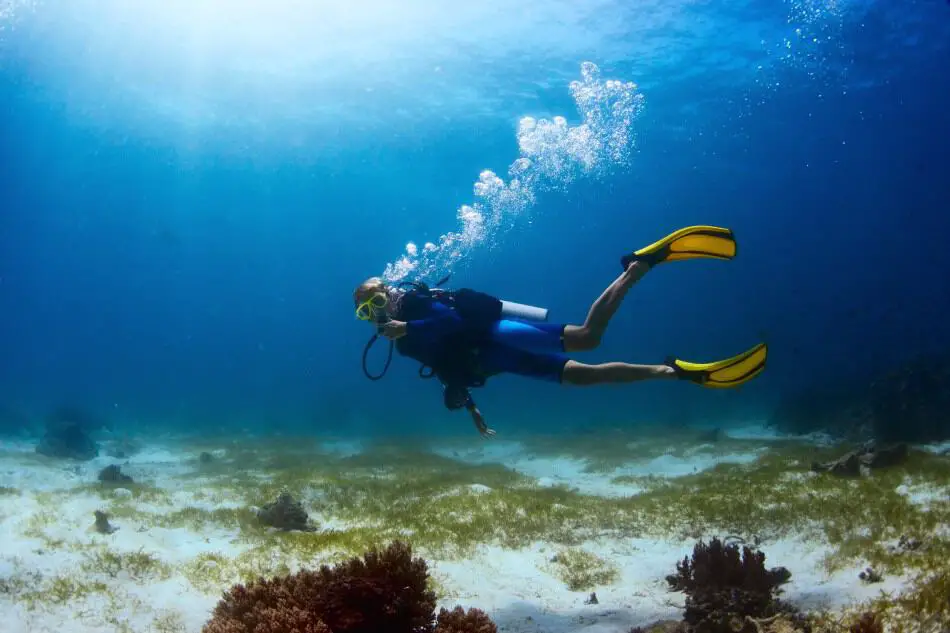
Should you rent or buy your equipment?
This answer varies from person to person. If you are just someone who is going on holiday, got a quick certification, and want to scuba dive once, there is obviously no point in buying equipment. You should in any case not dive without a diving certification! However, if you are someone that could potentially start diving more frequently, or are a diver, the circumstances are very different. There are a few situations where renting is better and a few where it is just better to buy your equipment; here are a few reasons for both:
When You Should Rent
Most diving packages or institutions will give you cylinders so those are something that you don’t have to rent. If you are a beginner, it is a good idea to rent the equipment you need so you can learn diving while seeing if it is the right adrenaline rush for you. There is no point in buying expensive equipment if you’re not a fan of the activity.
Another reason to rent is if you are someone who travels for diving a lot since the diving equipment can be quite heavy to lug around from place to place. Renting equipment in the long run though can be quite costly; however, you will not have to worry about equipment maintenance or storage. Travelling also requires different equipment for different water conditions; renting here would be a better option if you don’t want to have an excess of devices for one-time use.
When You Should Buy
If you are an avid diver, there is no reason you should not buy your own equipment. First and foremost, you will be comfortable; most rental places have unisex gear that is generically sized, whereas if you buy, you will be able to get your exact fit.
Comfort extends to safety as well; when you are comfortable with your own equipment, you will be more familiar with all the parts and devices giving you confidence and keeping you safer in unknown water.
What are the basics of maintaining your gear?
Servicing and maintaining gear goes a step ahead of just rinsing it and keeping it clean. There are many intricate parts of diving gear that either need to be serviced, replaced often, or generally looked after.
What are dive tables? Are they obsolete when you have a dive computer?
Before Getting in the Water
Start by stretching out all the rubber parts of your mask, snorkel, and fins (should you get open-heel or full-foot fins?) to look for any cracks as they can cause problems during your dive. Also, check for cracks in other clips and buckles as well as the lens glass. These need to be replaced immediately before the dive because they can be a danger while you’re underwater.
Before getting in the water, connect your regulator and take a few breaths to make sure it is working properly and reading accurately on the gauge. In the same way, inflate and release air from your BCD (like the Zeagle Ranger BCD) to check for any possible leaks that need to be repaired. Also, check your tank for the expiry date and see that all valves are functioning properly.
Finally, check your wetsuit for any rips or tears from your last dive, and patch them up if necessary to ensure that you are properly insulated.
After you’re out of the water
After you come out of the water, the first thing you should do is rinse your equipment with lukewarm water. Saltwater is going to rust any metal piece of equipment, which can be expensive to replace. If not rinsed, plastic equipment can grow mildew, which can be slimy and smelly and quite off-putting to fellow divers, along with you.
When you take off your gear, don’t just throw it on the floor; the impact can damage it and someone could potentially step on it. Instead, remove it and keep your gear in a gear bag and out of direct sunlight; the UV rays can damage your equipment just like they can your body.
How to store it
Wetsuits should be hung on wide hangers made of wood or plastic, not skinny metal ones that could rust and stain your suit, while fins, snorkels, and goggles should be stored in a loose bag to avoid any bends or dents.
Make sure the dust covers on your regulator are firmly in place to ensure their longevity. Rinse your BCD thoroughly with soapy water, and allow it to soak to ensure no salt crystals are left inside. Once cleaned, inflate the bladder halfway and store it like that; this will ensure that the walls don’t stick together.
For tanks, it is important never to store them completely empty as they can absorb moisture and contaminants, or completely full as they can crack. Instead, it is a good idea to have at least 300 psi of air and store them in a place where they are safe from getting knocked over.
What are the best travel BCD’s.? Find out!
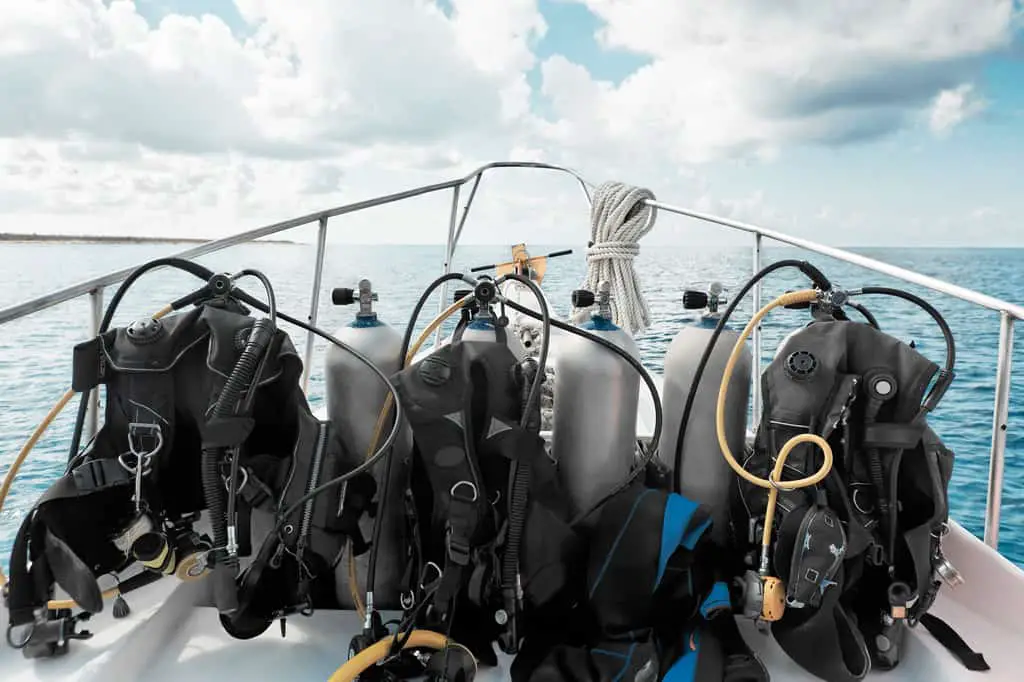
What do you do when you find an unconscious diver underwater?
Do’s and Don’ts of scuba diving
Do not dive by yourself
This is especially important if you are a beginner at diving. There is no good that can come from going underwater by yourself.
There are many different dangers you can encounter under the sea, that you might not know how to react to, especially if you are just learning how to scuba dive. Newer divers often use up their air supply a lot quicker than experienced ones, and you don’t want to be trapped underwater by yourself in case that happens.
Another thing that can happen is that you scrape yourself against something, lose your way or spot a dangerous marine animal. In any of these cases, it is either good to have a guide or a group of divers with you that can help you navigate out of danger.
Do not touch anything
You might be tempted to touch your brightly colored, sometimes inviting environment and the creatures within it, but keep in mind you are swimming on their turf. You don’t know anything about the creatures swimming with you or even the coral might see. The fish around you could be aggressive or poisonous, or the coral you want to pick up as a souvenir might sting you, so be careful!
Keep calm
Do not panic! 20% of diving deaths are caused because of panic. Keep calm and breathe slowly and steadily and keep still rather than heavily while trying to swim to the surface; you will quickly diminish your air supply and might aggravate surrounding predators.
Most problematic situations with diving can be gotten out of quite easily if you ask for the help of your instructor. If you need to get the attention of a diver, you can bang lightly against their tank so they hear you and can help you out.
Watch Your Surroundings
Be vigilant of your surroundings. Yes, there are many beautiful things surrounding you, but there can also be a great many dangers on the ocean floor. Keep constant communication with everyone you are diving with, in case you need their help or they need yours.
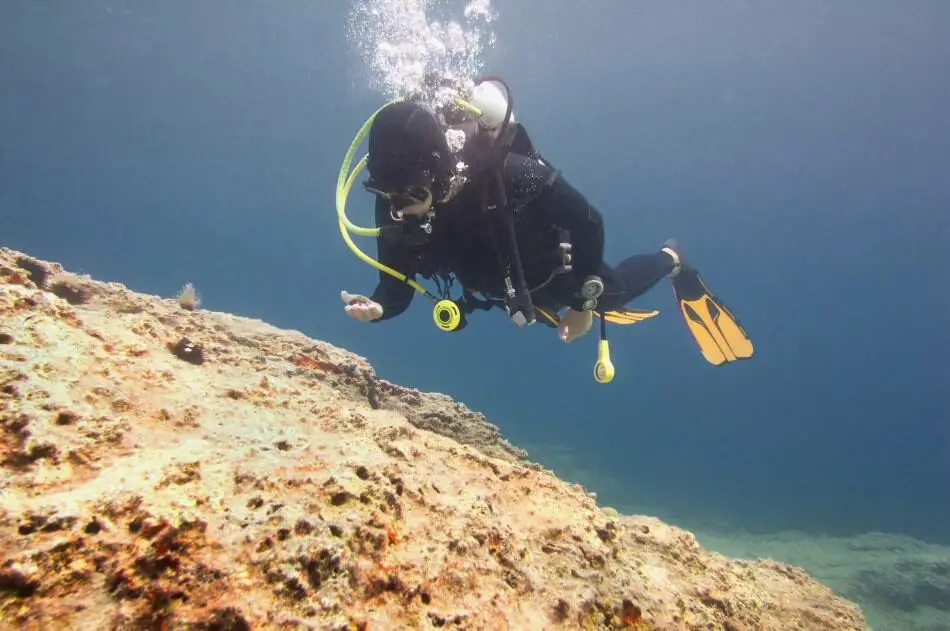
How good of a swimmer do you have to be to dive?
There is a bare minimum amount of swimming skills that you are required to have before you can be certified to go scuba diving. You need to be able to swim at least 200 meters on your own with no assistance and be able to stay afloat for 10 minutes without the help of extra equipment.
However, these standards for swimming are not something that everyone cannot achieve. You do not need to be a professional swimmer to go scuba diving.
How can you improve your breathing and breath-holding?
Like with most things, practice makes you better. You need to start by practicing deep breathing. This will help your lungs expel all low-quality air from your lungs.
Start practicing holding your breath, increasing your time as you go. This is not a process that happens over time. It can take months on end.
Submerging yourself in cold water can help slow down your heart rate, which will help you hold your breath for a longer period of time. An important tip to remember when trying to hold your breath is to be completely relaxed. Any kind of tension in your body will require you to expend your oxygen, making it more difficult for you to hold your breath.
Do you have to Build Stamina to Scuba Dive?
At the end of the day, scuba diving is a sport, and all sports require you to have some level of stamina. Scuba diving is a strenuous activity that requires you to use every muscle in your body to maneuver the water.
It is advised that you do some sort of high-intensity workout before you choose to go diving. Another reason why stamina is important is that you need to be able to control your breathing. If you get out of breath very quickly, you are sure to run out of oxygen and that could be a very disastrous situation.
There is a common misconception that this is a lazy activity that anyone can do, but this thought process is what leads to a lot of inexperienced divers getting into tragic situations.
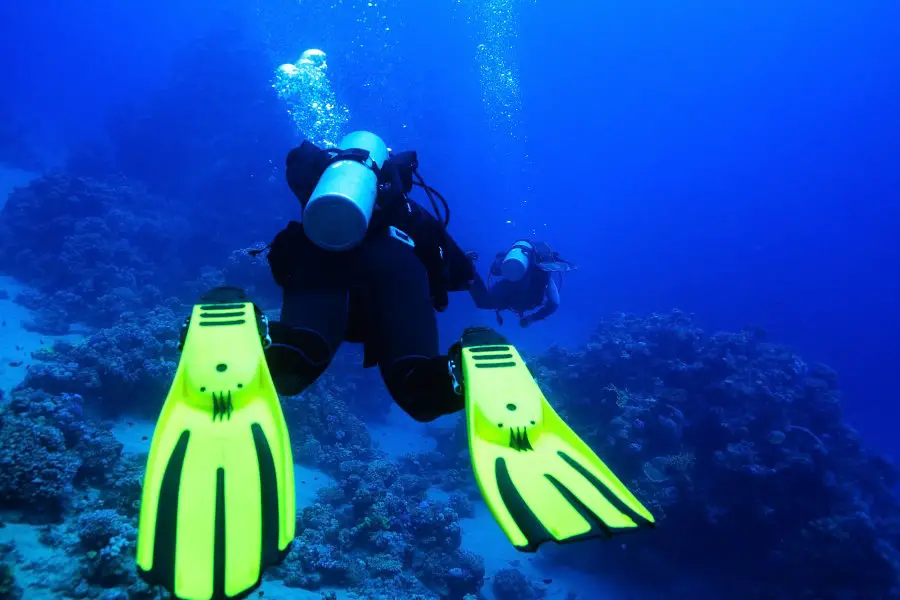
Final Thoughts
Diving can be a great adventurous activity that you can take up as a hobby or even as a career. It requires a lot of time and possibly even money, but it can be very fulfilling to be able to explore the marine world that not everyone gets the opportunity to do. Keep in mind that this activity requires a certification, a good instructor, a safe environment, and a lot of practice too.
Once you get the hang of it, you’re going to want to do it all over the world!

